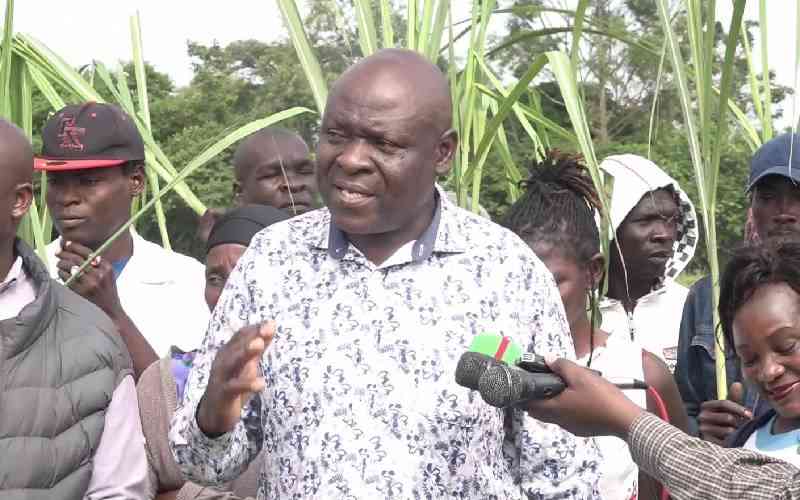By EMMANUEL WERE
KENYA: The announcement by the Energy Regulatory Commission (ERC) last week that the price of power for most households will drop beginning next month was met with a lot of confusion. Will ERC control fuel costs, inflation and foreign exchange that are considered in every household’s bill, yet the commission has no control of these factors? Did the Acting Director General Frederick Nyang promise what cannot be delivered? Business Beat’s Emmanuel Were interviewed him and below are the excerpts.
One of the contentious assertions is that the fuel costs in the power bills will reduce, yet Kenya is subjected to the variance of the international oil market and currency fluctuations. How certain are you of the drop in fuel prices?
We are changing the generation mix of how we produce power, which is going to be heavily in favour of renewable sources starting with geothermal. With geothermal, you don’t need thermal plants. This will reduce the amount of fuel used. But as the country embarks on achieving the target of 5,000 MW in 40 months, we will bring on board coal and liquefied natural gas (LNG), which will account for 70 per cent of this new power. The fuel we will pay for the coal and LNG is much lower. The government is going to procure the fuel directly from the governments of Qatar and Kuwait. This protects us against the fluctuations in the market. This agreement should be in place by end of the year. When President Kenyatta recently visited Kuwait he was accompanied by the Cabinet Secretary of Energy and Petroleum Davis Chirchir, that shows how seriously we are taking it.
The households which use less than 50 units will benefit most as their unit of power drops starting December, why this group and not manufacturers and heavy users?
We took particular recognition as to who we would refer to as vulnerable consumers by giving them what is known as the lifeline tariff. These are consumers who consume up to 50 units per month. We have given them substantial relief beginning next year. What you probably did not notice is that we have also given the small commercials (jua kali) a small relief right from year one. if you add those two groups, the domestic and small commercials we are already talking of 99 per cent of the consumers in this country. Commercial and industrial consumers also get relief after six months. When tariffs are effective starting December, small commercials and domestics get that relief and then from July, everybody benefits from the relief.
Why the increase in tariffs for the first six months for other users?
The non-fuel component of the power is the one that increases and this basically goes to pay for the new infrastructure that we are putting in place. It includes new generation facilities it also includes network improvement facilities. You need to put in an investment to have a robust network and also because consumption is going up we need to put in new generation facilities. In our view that the customer categories that need to shoulder the burden are the industrial and commercial customers and that is why we have decided to increase their tariffs over the six months.
Don’t you think it would have been more prudent to have the industrial consumers pay less because they create more jobs and increase production in the country?
Yes, that is a good consideration but when the regulator is looking at this, the first thing they consider is the cost of providing the service. We felt that the commercial and industrial consumers should carry a little more of the burden to benefit domestic consumers, particularly those consumers on the lifeline tariff. This is because of the cost the industrial consumers have on the system.
What power plants will have been added to see fuel costs on retail tariffs drop substantially from Sh5.19 per Kwh to Sh1.89 per Kwh? How much of the geothermal will have come in place?
We looked at our energy balance and KenGen intends to add 560 MW of power from geothermal to the grid. We have asked KeGen to fast track the coming on board of this power. As we speak, 70 MW will come onboard in December to replace thermal generation. The next 70 MW will come in April bringing the total to 140 MW. That already displaces a lot of thermal generation.
The way the cost of power was presented, just the fuel and non-fuel costs have raised a lot of questions about transparency. What assurance will the regulator give on the transparency of setting the energy prices?
I agree that transparency is essential. If you look at the bill that Kenya Power sends to consumers, it is broken down and analysed. However, at the end of the day the bill includes all those things. We are aware that there is the component that varies. We want total transparency and also that the total bill is understood because at the end of the day the consumer pays a total bill, he does not pay one bill for electricity and another bill for fuel.
Stay informed. Subscribe to our newsletter
When you have a generating plant in place, the infrastructure is there for it to generate the electricity but it needs to use fuel. So the fuel is an important component of the electricity that you enjoy. In terms of clarity the bill is clear. I do not think there is any confusion that comes to the consumer as a result of looking at the bill. The issue of whether we have taken it into account, I think is overplayed.
Where has the review in tariffs left Kenya Power?
According to the application Kenya Power made in February, they had made an indication of how much power they need to sell for every year of the tariff control period. In the final approval that we have given them, the energy sales that they have to make is different than what they had applied for.
You said Kenya Power has to be very sincere on how it prices its services. Has Kenya Power won or lost?
We believe they can sell much more than they had indicated in their application. For instance, they had indicated that the growth (in sales volume) between the first and second year would be only six per cent. However, in the approval we believe the growth will be seven per cent and so the tariff that we have given them is based on the growth numbers. We had to go back and discuss with them that is why the whole process takes a long time.
Kenya Power puts in an application and says this is what we can do, the consumer and stakeholders listen and give their representations.
We believe that the growth targets Kenya Power had given them were rather low.
We decided to adjust and we believe in the first year and second year, they will grow at seven per cent and in the third year we expect they will grow by eight per cent.
What we need to consider is that we need to have a viable and vibrant Kenya Power because the market model is that Kenya Power is the only entity, which buys power and sells to the consumers.
With the consumption tariffs falling, isn’t Kenya Power a big loser?
The idea is to enable us enjoy economies of scale and lowering of the tariffs with the bigger units of power, like the 140 MW of geothermal coming on board. In the past, we have added small units of power to the grid. If the tariffs are lowered, then we are sure those who want to invest in industries which use electricity, will be comfortable.
We are pushing Kenya Power to sell more volumes; we believe if they are capable we don’t see any reason why it should not happen. We expect the overall tariff to go down so as a country we will be able to benefit from the economies of scale and they will benefit by them selling more power over the tariff control period.
How come you did not apply for the position of Director General of the ERC?
I chose not to because of personal reasons.
[email protected]
 The Standard Group Plc is a
multi-media organization with investments in media platforms spanning newspaper
print operations, television, radio broadcasting, digital and online services. The
Standard Group is recognized as a leading multi-media house in Kenya with a key
influence in matters of national and international interest.
The Standard Group Plc is a
multi-media organization with investments in media platforms spanning newspaper
print operations, television, radio broadcasting, digital and online services. The
Standard Group is recognized as a leading multi-media house in Kenya with a key
influence in matters of national and international interest.
 The Standard Group Plc is a
multi-media organization with investments in media platforms spanning newspaper
print operations, television, radio broadcasting, digital and online services. The
Standard Group is recognized as a leading multi-media house in Kenya with a key
influence in matters of national and international interest.
The Standard Group Plc is a
multi-media organization with investments in media platforms spanning newspaper
print operations, television, radio broadcasting, digital and online services. The
Standard Group is recognized as a leading multi-media house in Kenya with a key
influence in matters of national and international interest.








